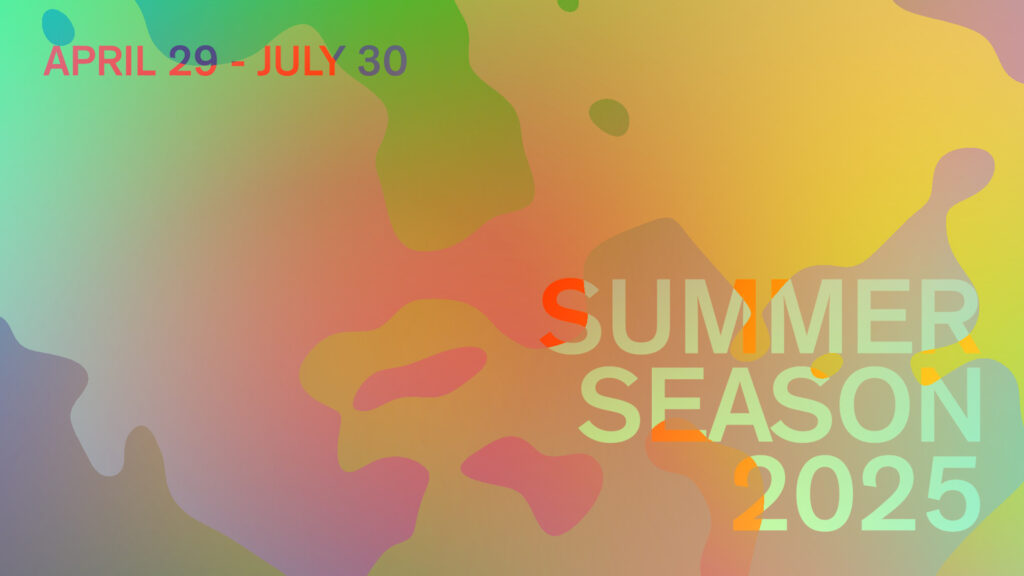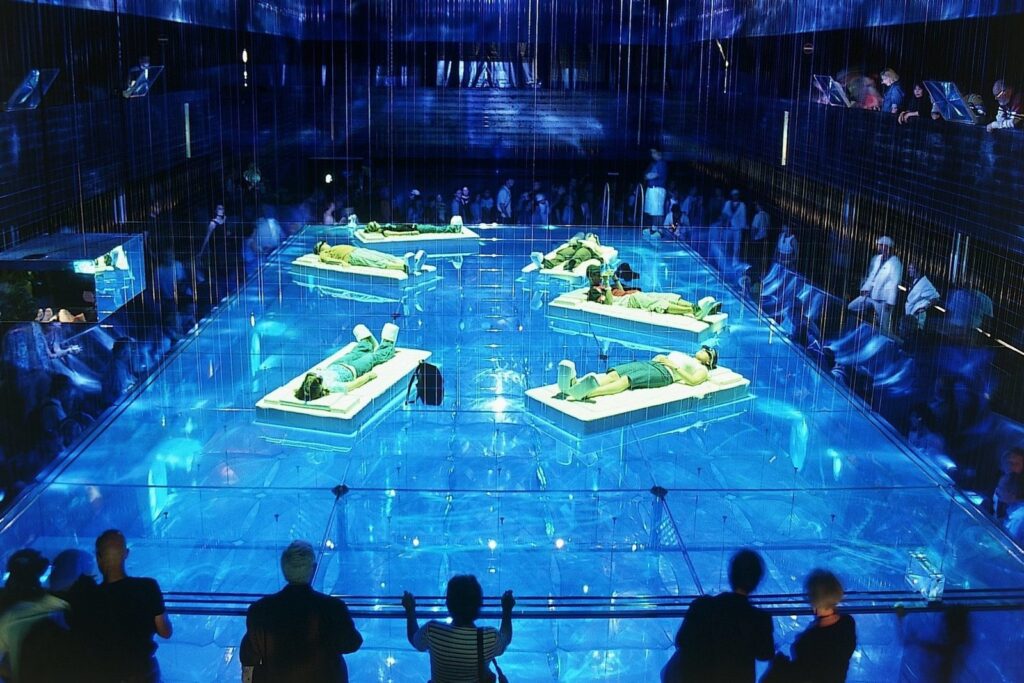Learning vvvv & VL
You have come to the right place to learn – not only about the visual programming environment vvvv, but also to get started on your own journey with this fascinating tool.
Why choose vvvv?
vvvv is a powerful visual programming environment designed for artists, designers, and technologists to create real-time generative art, interactive installations, and immersive visual experiences. Unlike other tools, vvvv offers a very granular control and supports the full .NET ecosystem, enabling seamless integration of advanced libraries. That is why vvvv calls itself a visual programming environment for .NET. It also stands out with multi-threading capabilities for smooth performance, state of the art 2d and 3d rendering pipelines and the option to export your patches as native Windows applications.
Used by professionals all over the world, vvvv is perfect for large-scale projects that demand real-time processing and complex visuals. Whether you’re crafting interactive installations and spaces or live shows, vvvv provides the flexibility and power needed to push creative boundaries thanks to its rendering engines based on Stride, Skia and Fuse.
When talking about visual programming environments, vvvv stands out where you might hit limitations in other environments. Unlike others that restrict you to curated high-level node sets, vvvv allows you to extend its functionalities completely visually by essentially patching C# and shader code directly. This unparalleled flexibility means you can overcome obstacles and push your creative boundaries further than ever before.
Intuitive Visual Programming
vvvv’s node-based visual programming interface makes it incredibly easy to get started. You can create complex multimedia projects without writing a single line of code, simply by connecting nodes. Perfect for visual thinkers and beginners, vvvv offers an approachable entry into the world of programming.
Real-Time Operation
Designed for real-time operation, vvvv allows you to see changes instantly as you create. Thanks to its state hot-reload technology, vvvv skips the built step and knows only one mode: Runtime. Ideal for rapid prototyping, where immediate feedback is crucial. It allows you to modify your program while it is running, with compilation happening seamlessly in the background. This saves you time by instantly showing the effects of your changes without needing to restart your program.
The Visual Language Powering vvvv
vvvv acts as the development environment for VL, its powerful visual programming language. VL enables multi-paradigm programming by combining elements from dataflow, functional, and object-oriented programming, providing a rich and versatile environment. VL combines visual code blocks for loops, conditions, and more, making it easy to create complex logic without writing code. With VL, you get the flexibility to tackle more complex projects and enhance your creative possibilities. VL also provides an advanced type system, ensuring reliability and efficiency with automatic type detection and support for both simple and complex data types. The development environment includes real-time feedback, debugging tools, and support for asynchronous programming and multithreading.
Extendability and Openness
vvvv supports a wide range of input devices and protocols, making it highly versatile for interactive applications. Whether you’re working with sensors, audio/visual devices, or other software environments, vvvv has you covered. And if you miss a node implementation for a device, you can add it on your own by accessing any .NET library completely visually.
Harness the Power of .NET—With or Without Code
With vvvv, you can easily leverage the full .NET ecosystem without writing any C# code. Simply reference any available NuGet library, and it becomes accessible through the visual node browser, significantly expanding your toolkit for creative projects. However, for those who prefer coding or when text-based code makes more sense for certain tasks, vvvv offers the flexibility to write C# directly. This makes vvvv a perfect fit for both visual programmers and traditional developers, ensuring that no matter your workflow, you have the power to customize and extend your project as needed.
Export Executables
Unlike other visual programming environments, vvvv allows you to export your projects as standalone Windows executables and Linux Console apps. This means you can share your work easily, run it on different machines without vvvv installed, and even distribute your creations commercially.
2D, 3D & GPU-Accelerated Visuals
vvvv comes with an integrated set of rendering technologies for different types of visual output. All engines are designed to interoperable.
Stride (3D Engine) – vvvv wraps the core of the Stride Game Engine, making its real-time 3D rendering capabilities accessible through visual patching. Instead of dealing with traditional game engine workflows, users can directly work with PBR materials, lighting, shadows, physics, and post-processing effects, all in an intuitive, node-based system.
Skia (2D Engine) – A fast, GPU-accelerated vector graphics engine for creating motion graphics, UI elements, and generative designs. It enables smooth transformations, real-time text rendering, and precise 2D drawing, making it a great choice for interactive visuals and data visualization.
Fuse (GPU-Based Visual Patching) – A high-performance GPU programming framework that allows real-time shader creation, procedural graphics, and complex image processing—all visually, without the need for writing shader code. Fuse enables interactive, GPU-accelerated workflows that are ideal for real-time art and performance applications.
Community and Resources
Benefit from a collaborative community and extensive resources that help you maximize your creative potential.
Flexible Licensing Model
vvvv offers a flexible licensing model, advantageous for artists and small studios working on a budget. With vvvv’s unique T.R.U.S.T model, you’ll learn without the hassle of copy protection, feature limitations, or mandatory registration. The vvvv developers trust that, as you advance your skills, you’ll declare your commercial use honestly, supporting the continued development of this incredible tool.
Get started with vvvv at the NODE Institute
If you’re new to vvvv, here’s a recommended learning path to help you build a solid foundation and kickstart your journey with vvvv.
1. Official Documentation
Start with the Getting Started section of The Gray Book, the official documentation for vvvv gamma. This resource walks you through the fundamentals of the development environment, the visual programming language VL, and essential workflows. A must-read for every beginner!
2. Video Tutorials
To complement the documentation, check out these free youtube beginner-friendly tutorial series by our vvvv instructor Christoph, covering the most basic nodes and techniques to get you started with the visual programming environment vvvv and its programming language VL:
3. The Beginner Class
Twice a year, The NODE Institute offers the ultimate kickstarter course for vvvv beginners. This 12 session long class takes you from zero to creating your own interactive applications.
✅ Learn all the core concepts of vvvv gamma in a structured way
✅ Get personal guidance from an expert instructor
✅ Engage with a supportive community of creative coders
4. Professional Courses

Once you have mastered the Beginners course, you can expand your knowledge on many different areas following the Professional Courses. Whether you want to master GPU programming, generative design, interactive installations, or real-time 3D graphics, there’s a course for you. Also check out our free courses and Creative Masterclasses
5. Join the meetups

We facilitate and organise regular vvvv user meetings, known as the vvvvorldwide meetup, to which we invite speakers from the community, that share facsinating talks about their work at the intersection of art and technology.
Explore our archive on YouTube
vvvv History

Initially developed by Frankfurt based media studio MESO as an in-house tool to create real-time media installations, in the early 2000s vvvv amassed a global community that continuously develops the visual programming software further. MESO and many other professional studios became key drivers for avant-garde projects, produced many innovative installations with vvvv and engages in a mutually beneficial relationship with the creative software developers.
Being able to program in real-time and produce complex reactive media environments while operating on a graphical interface was the challenge set by the team of early vvvv developers Sebastian Oschatz, Max Wolf, Sebastian Gregor, and Joreg.
Over the past decade, design as well as art affiliated disciplines have profited from an extended repertoire of digital tools and rising technologies, with vvvv being one of the trendsetters in the field of creative coding. This is due in part to its graphical interface, which makes it appealing for designers who are used to iterative solutions.

Today, the use of vvvv has spread worldwide and it is a widely-used professional tool from immersive live visual set ups to actual product prototypes, from artistic projects to award-winning stage presentations on international trade fairs.
Driven by a diverse and high profiled community of visual artists and other software creatives vvvv has been maturing over the past decade to an industry standard when it comes to interactive environments.
In the early years, NODE Forum for Digital Arts became vvvv’s “real-life” platform for informational interexchange, which has by now grown into one of Europe’s biggest media arts festivals. The NODE Institute emerged in 2019 from the need of ongoing education all over the year.
